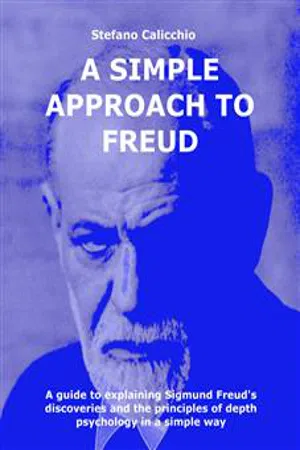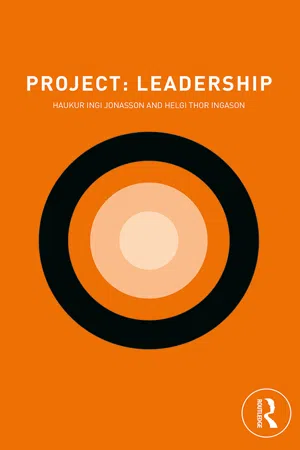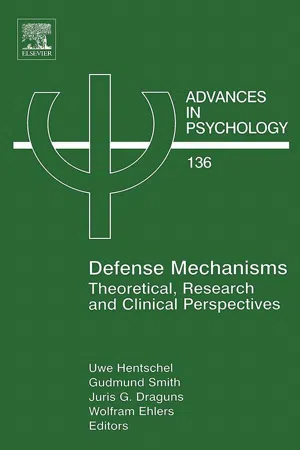Defence Mechanisms
Defence mechanisms are psychological strategies that individuals unconsciously use to cope with anxiety and protect themselves from perceived threats. These mechanisms can include repression, denial, projection, and rationalization, among others. They serve as a way for individuals to manage internal conflicts and maintain a sense of psychological equilibrium.
7 Key excerpts on "Defence Mechanisms"
- Jessica Kuper, Jessica Kuper(Authors)
- 2015(Publication Date)
- Routledge(Publisher)
...Defences DOI: 10.4324/9781315677101-42 The conceptualization of ego mechanisms of defence presents one of the most valuable contributions that Sigmund Freud and psychoanalysis have made to psychology. Modern psychiatrists, including non-Freudians, define Defence Mechanisms in a more generic sense, as innate coping styles which allow individuals to minimize sudden, often unexpected, changes in internal and external environment and to resolve cognitive dissonance (psychological conflicts). Defences are deployed involuntarily, as is the case in physiological homeostasis, and in contrast to so-called ‘coping strategies’. Evidence continues to accumulate that differences in how individuals deploy defences – their unconscious coping styles – are a major consideration in understanding differential responses to environmental stress. For example, some people respond to stress in a calm, rational way, whereas others become phobic or sarcastic or emotional. These different responses are intelligible in terms of different defences. In 1894, Sigmund Freud suggested that psychopathology was caused by upsetting affects, or emotions, rather than disturbing ideas. Freud observed that the ego's Defence Mechanisms can cause affects to become ‘dislocated or transposed’ from particular ideas or people, by processes which Freud later called dissociation, repression, and isolation. However, affects could be ‘reattached’ to other ideas and objects through displacement, projection and sublimation. Freud identified four significant properties of the defences: (1) they help manage instincts and affects; (2) they are unconscious; (3) they are dynamic and reversible; and (4) although the hallmarks of major psychiatric syndromes, in most people they reflect an adaptive, not a pathological, process. The use of Defence Mechanisms usually alters the individual's perception of both internal and external reality...
- eBook - ePub
A simple approach to Freud
A guide to explaining Sigmund Freud's discoveries and the principles of depth psychology in a simple way
- Stefano Calicchio(Author)
- 2022(Publication Date)
- Stefano Calicchio(Publisher)
...Defence Mechanisms According to Freud, the experiences during the different stages of childhood development just described represent the foundations of an individual's personality. Through the study of the psychic apparatus in the process of maturation, psychoanalysis determines the anxieties and desires repressed by people experiencing distress. Through their symptoms, patients express real psychophysical representations of situations and events that they were unable to resolve in the early years of their lives. The analysis thus reconstructs a posteriori the major problems experienced during the childhood phase. Problems that are strongly connected to the evolution of sexuality and drive energy. It is within the framework of this analysis that Freud identifies the so-called Defence Mechanisms. These are unconscious strategies that people put in place with the aim of maintaining an acceptable level of drive and psychic energy. Characteristic personality traits are influenced by the more or less conscious use of these defence strategies. The human being therefore seeks an adaptive compromise, so that the symptom allows the discharge of excess psychic energy and thus the anguish arising from the unresolved conflict. In reality, these defences can be adaptive or non-adaptive with respect to reality...
- (Author)
- 2020(Publication Date)
- Wiley(Publisher)
...Psychodynamic Perspective of Defense Mechanisms Phebe Cramer Williams College The concept of defense mechanism refers to a mental process that occurs outside of awareness. This concept is one of the most important parts of classical psychoanalytic theory. In contemporary theory, the concept has been expanded, and its function has been elaborated. As currently understood, the defense mechanism functions to keep the individual unaware of thoughts or feelings that would arouse anxiety or loss of self‐esteem if consciously recognized. Defenses occur as part of normal development, but if used excessively or if age‐inappropriate, they may signal the presence of psychopathology. The idea of a defense mechanism was originally presented by Sigmund Freud (1894), who found that people have the capacity to keep painful thoughts or feelings from becoming conscious. Freud (1895 /1966) also noted that defenses may explain symptoms of psychopathology. As his work progressed, Freud focused on the role of instinctual drives for understanding human behavior. At this point, defenses were thought of as a counterforce that prevented the discharge of drives. Several different defense mechanisms were proposed. These were considered to be processes with the function of protecting the person from experiencing excessive anxiety. The work of Anna Freud (1936) elaborated on the motives for defense use. On the one hand, the pressure for discharge of instinctual drives produces an anxiety signal, which results in the use of a defense mechanism to “ward off” the feeling of instinctual anxiety. Anxiety can also emanate from the violation of external prohibitions (objective anxiety), or it may occur when the dictates of internalized prohibition – i.e. conscience – are violated (super‐ego anxiety). In these latter cases, the motive for defense has a different origin, namely, the warding off of feelings of guilt...
- Annamaria Di Fabio, Donald H. Saklofske, Con Stough(Authors)
- 2020(Publication Date)
- Wiley(Publisher)
...Defense Mechanisms, Contemporary Perspectives Aleksandar Dimitrijević International Psychoanalytic University, Berlin, Germany The concept of defense mechanisms was first introduced by Sigmund Freud in 1895, as part of his theory of the dynamic unconscious and as part of his understanding of psychopathological phenomena and their treatment. In Freud’s conception, psychic life was a constant battle between wishes and prohibitions. While wishes, connected by Freud with the unconscious drives, influence human behavior and decisions, prohibitions make possible civilized life, where only certain wishes can be satisfied in a certain way. To find a compromise between the two, the Ego deploys defense mechanisms in order to find a non‐prohibited satisfaction in reality or fantasy. Defense mechanisms are unconscious (just as drives and wishes are) and are being activated automatically. It is impossible for one to decide whether to use them or not. This makes it difficult for us to recognize that we are using defense mechanisms or to introduce changes in the modes of usage. The function of defense mechanisms can be twofold. First it is related to the reduction of anxiety provoked by forbidden wishes, as described above. Second, they may help us achieve and/or retain social desirability and make (almost) perfect self‐representations, hiding unacceptable wishes from ourselves and others. Defense mechanisms are not pathological phenomena per se. They are used by everyone in our everyday lives and are rather helpful. If they are, however, used too frequently and/or too rigidly, that may lead to specific character structures and mental disorders, while some defense mechanisms are believed to be typical for certain mental disorders (see below)...
- eBook - ePub
- Haukur Ingi Jonasson, Helgi Thor Ingason(Authors)
- 2018(Publication Date)
- Routledge(Publisher)
...We have explained that Defence Mechanisms build on instinctive tendencies of the self to defend your self-awareness and self-image as project leader. This is a good foundation on which to proceed to the next chapters, which delve still further into your self-understanding and introduce what will be referred to as the economy of the mind. Reflection points: • How is it possible to work through something that is unconscious? • What other methods, not cited above, does the self use to protect itself? • What would characterise someone who did not use any Defence Mechanisms of the self? • Describe how Defence Mechanisms of the self can relate to mental difficulties. • How can predominant Defence Mechanisms grant an individual leadership authority? • What consequences can result if an individual with significant, prevailing Defence Mechanisms reaches a position of power? References Blaxter, M. (2010). Health, 2nd Edition. Cambridge, UK: Polity Press/Wiley. Bowlby, John (1982). Attachment and loss, Volume 1: Attachment, 2nd Edition. New York: Basic Books. Cramer, P. (1991). The development of Defence Mechanisms: Theory, research, and assessment. New York: Springer-Verlag. Freud, Anna (1937). The ego and the mechanisms of defence. London: Hogarth Press and Institute of Psycho-Analysis. Paulhus, D. L., Fridhandler B., & Hayes S. (1997). “Psychological defense: Contemporary theory and research” in Briggs, S., Hogan, R. G., and Johnson, J. W. Handbook of Personality Psychology. 543–579. Boston, MA: Academic Press. Swann, William (1996). Self-traps: The elusive quest for higher self-esteem. New York: Freeman. Tillich, Paul (1961). “The meaning of health.” Perspectives on Biology and Medicine, 5(1), 92–100. Vaillant, George E. (1977). Adaptation to life. Boston, MA: Little, Brown. Vaillant, George E. (1992). Ego mechanisms of defense: A guide for clinicians and researchers. Washington, D.C.: American Psychiatric Publishing....
- eBook - ePub
- Nick Midgley(Author)
- 2012(Publication Date)
- Routledge(Publisher)
...Not content with cataloguing the Defence Mechanisms which had already been identified in her father’s work (such as repression, reaction-formation, regression, undoing, isolation, introjection, identification, projection, turning against the self, reversal and sublimation), Anna Freud also asked the more profound questions: What is it that the mind is protecting itself from when it makes use of defensive mechanisms? How do these mechanisms develop? Are some mechanisms of defence more ‘primitive’ and some more ‘mature’? Are there other Defence Mechanisms besides those already identified by Sigmund Freud? And what is the connection between Defence Mechanisms, psychopathology, and mental health and well-being? Why does the mind need to use defensive mechanisms? Although Anna Freud accepted Freud’s definition of the mechanisms of defence as ‘all the techniques which the ego makes use of in conflicts which may lead to a neurosis’ (S. Freud, 1926: 163), in the course of her book she actually considerably expands the meaning of the term, looking at the ways in which the mind protects itself from all kinds of painful or unpleasant feelings (not just conflicts), both in the course of normal development and in neurosis. The area that was already most familiar to psychoanalysis was the way in which the psyche responds to anxiety related to internal conflicts between an (unconscious) wish and the part of the mind that rejects such wishes. In neurosis, this can be understood as ‘super-ego anxiety’, which from Anna Freud’s perspective forms the basis of all neurosis in adults. As she explains it, ‘some instinctual wish seeks to enter consciousness … but the super-ego protects...
- eBook - ePub
Defense Mechanisms
Theoretical, Research and Clinical Perspectives
- Uwe Hentschel, Gudmund Smith, Juris G Draguns, Wolfram Ehlers(Authors)
- 2004(Publication Date)
- North Holland(Publisher)
...Moreover, all defense mechanisms may be physiologically rooted, but not necessarily to the same extent. Repression, for example, is likely to feature a greater number of physiological correlates and displacement, more numerous behavioural indicators. In several current texts in psychophysiology (Bradley, 2000), we have failed to find an index entry for defense mechanisms. The closest term that was included was Pavlov’s ‘defensive reaction’ or ‘defensive reflex’ that constitutes the avoidance counterpart to the orienting reaction, a concept that, at most, shows some overlap with defense mechanisms. At this point, defense mechanisms continue to be detached from the psychophysiological research enterprise, and one can only speculate on the reasons for this separation. On the part of psychoanalysis, affinity to neuropsychology has been reactivated. The exchange of ideas has been resumed, and the time is ripe for including defenses in this endeavor. Pending a conceptual resolution of the mind-body dichotomy, physiological indicators of defense may be construed as one of the several interfaces between the mind and the brain. In the optimal case, defenses help to protect the individual from external as well as internal dangers. Moreover, they accomplish this task largely outside of the person’s scope of awareness. In the worst scenario, they fail to reduce the person’s distress or the individual ends up paying a high price for securing, for example, protection from forbidden impulses but developing a neurotic symptom in the process. Chances of getting effective relief from suffering are higher with mature than with immature defenses, but even mature defenses can fail. There is also probably a higher degree of awareness and conscious control in mature defenses. Humor and suppression, for example, can be used deliberately. Coping and Physiological Reactions Physiological reactions appear to provide the most direct connection between the concepts of defense and those of coping...






